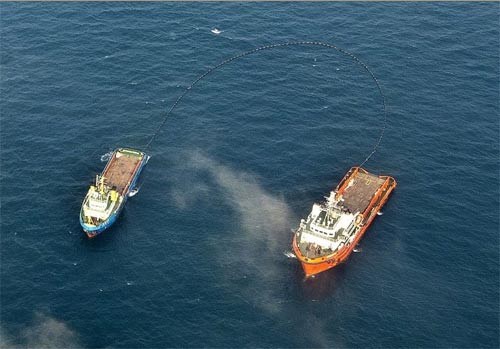(Ecns.cn)--It has been half a year since the oil spill debacle began in Bohai Bay, an environmental tragedy that has since polluted 6,200 square kilometers of water – an area half the size of London.
According to China's State Oceanic Administration (SOA), ConocoPhillips China violated the overall development plan in its production at Penglai 19-3 oilfield, and is responsible for the accident.
However, on December 16, ConocoPhillips announced during interviews with foreign media that it had found no evidence of environmental pollution at Penglai 19-3 oilfield after conducting water quality testing and a coastal investigation, reported the China Economic Weekly on Tuesday.
On December 19, the company said that its research and analysis had so far shown the oil spills in Bohai Bay had caused "minimal lasting impact to the environment," according to a Xinhua report.
Hard to prove
Attorney Jia Fangyi has brought judicial proceedings on behalf of fishermen against ConocoPhillips to courts in Hainan, Qingdao and Tianjin. However, the courts have rejected his appeals based on "insufficient evidence," which means the fishermen must now shoulder the burden of proof, according to China Economic Weekly.
As ConocoPhillips denies any environmental pollution, the fishermen must prove on their own that the oil leaks led to the death of marine life and gravely-affected their livelihoods.
"The tort party has an obligation to provide the amount and area of the oil leaks," Jia said. "The plaintiff only needs to provide the obvious evidence, such as polluted water and contaminated seafood."
The related government institutes have an obligation to publicize their investigations, said Yin Fuqiang, another lawyer. If the court files this case, the fishermen can appeal to obtain evidence from related government departments, he added.
However, at present, no government institutes have shown any intention to provide their investigations as proof, reported the China Economic Weekly.
Inaction from all sides
"At the beginning of December, the cases involving ConocoPhillips were overdue for filing, but the Qingdao Court had no response to this," said Jia Fangyi. Until now, not a single case from the attorney has been filed by related courts.
"The courts have made no response towards the cases they have received. This is judicial inaction," said Jia.
According to another attorney, 107 fishermen jointly sued ConocoPhillips China at the Tianjin Maritime Affairs Court on December 12, asking for compensation of 490 million yuan.
But "every year the annual claim settlement rates of courts are examined on December 22," said Yin Fuqiang. "The 107 fishermen's lawsuit was proposed at an awkward time, because the court is probably unwilling to file the case before the assessment."
In August, the Chinese maritime authority announced it would sue ConocoPhillips over two oil spills on behalf of the state, yet after several months the lawsuit has yet to be heard.
ConocoPhillips said in September that it would establish a fund for the oil spill accident to cover the entire cost of the clean-up, repair and compensation. "We will soon announce and update information about the Bohai Bay fund," said a source from ConocoPhillips China on December 20.
As of now, the website of the Bohai Bay Fund (www.bohaibaycompensationfund.com) says only "coming soon" in English and Chinese.
Playback of events
June 4 and 17, two oil leaks successively occur at Penglai 19-3 oilfield. In the following days, 840 kilometers of seawater is found to be severely affected, degrading from Grade I to Grade IV. The State Ocean Administration (SOA) orders ConocoPhillips, the company responsible for the accident, to seal the oil leaks by August 31.
July 6, ConocoPhillips holds a press conference and announces that the oil leaks are under control.
August 12, ConocoPhillips admits that two more oil spill sources have been found at Platform B of Penglai 19-3 oilfield, and that they had covered the wrong positions instead of the oil leaks. One week later, the company admits to nine oil spill sources at Platform C of Penglai 19-3 oilfield.
December 13, the SOA investigates oil spills still occurring at Platform C of Penglai 19-3 oilfield. The highest frequency is four spills per minute.
December 16, ConocoPhillips claims there is no evidence of environmental pollution.


















